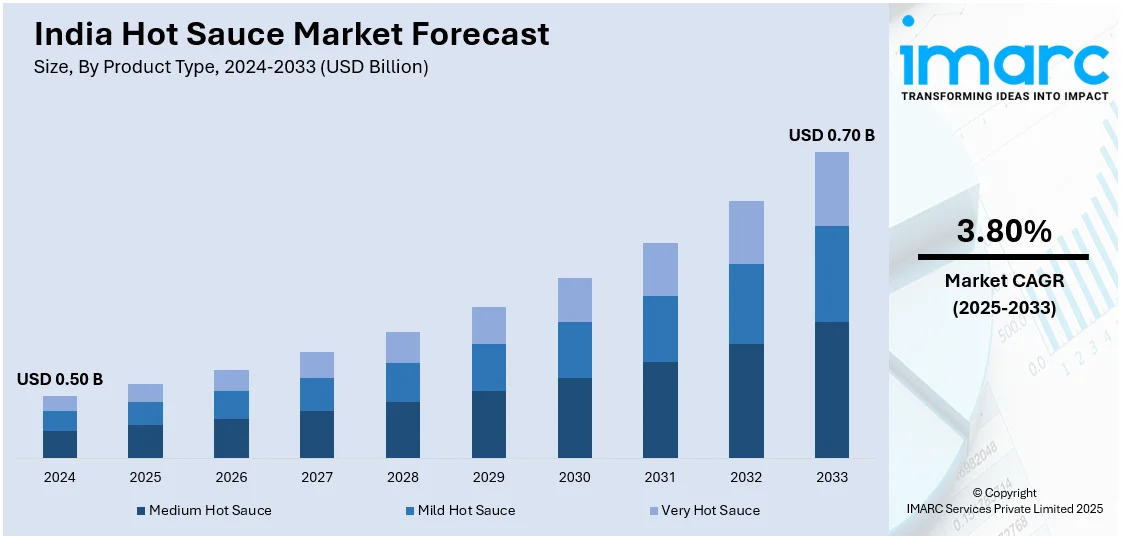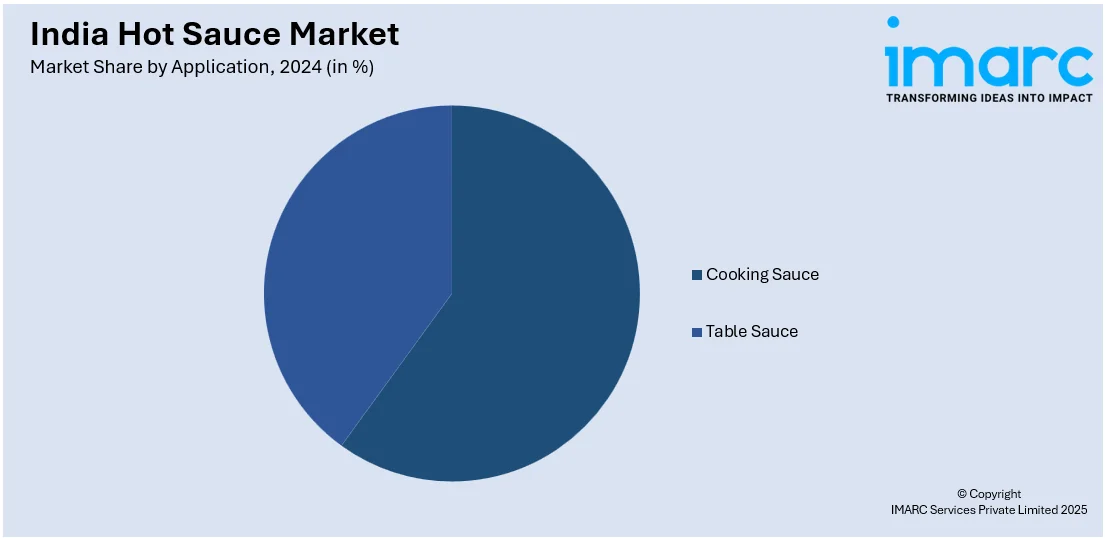
India Hot Sauce Market Size, Share, Trends and Forecast by Product Type, Application, Packaging, Distribution Channel, End-Use, and Region, 2025-2033
India Hot Sauce Market Overview:
The India hot sauce market size reached USD 0.50 Billion in 2024. Looking forward, IMARC Group expects the market to reach USD 0.70 Billion by 2033, exhibiting a growth rate (CAGR) of 3.80% during 2025-2033. The market is experiencing steady growth due to rising demand for global flavors, fusion with Indian cuisine, and growing e-commerce presence. Introduction of regional chili-based products and increased usage in both households and foodservice are also driving the market across India.
|
Report Attribute
|
Key Statistics
|
|---|---|
|
Base Year
|
2024 |
|
Forecast Years
|
2025-2033
|
|
Historical Years
|
2019-2024
|
| Market Size in 2024 | USD 0.50 Billion |
| Market Forecast in 2033 | USD 0.70 Billion |
| Market Growth Rate 2025-2033 | 3.80% |
India Hot Sauce Market Trends:
Rising Demand for Spicy Global Flavors
The growing exposure to international cuisines through travel, television and social media is reshaping consumer taste preferences in India. Spicy condiments especially hot sauces from Mexican, Korean and American cuisines are gaining strong traction. This shift is fueling India hot sauce market growth with urban consumers increasingly incorporating these sauces into daily meals. Restaurants, quick-service outlets and cloud kitchens are actively introducing global dishes featuring hot sauces to meet evolving demands. Supermarkets and online platforms are also expanding their imported hot sauce sections reflecting rising demand. Younger consumers are showing strong preferences for bold fiery flavors moving beyond traditional Indian chutneys and pickles. As palates become more adventurous the influence of global spicy flavor trends is expected to further deepen across both retail and foodservice segments in India.

E-commerce Growth
E-commerce is playing a major role in expanding the reach of hot sauce brands across India. Online platforms like Amazon, Flipkart and niche gourmet sites are making a wide range of products including international, small-batch and regional chili-based variants available to consumers nationwide. According to the report published by IBEF, the Indian online grocery market is projected to surge to US$ 26.93 billion by 2027 up from US$ 3.95 billion in FY21 with a CAGR of 33%. In FY23 e-commerce GMV reached US$ 60 billion reflecting growth in diverse segments as digital adoption continues to rise across the country. This accessibility is helping smaller and imported brands overcome traditional retail limitations and reach a broader audience especially in tier 2 and tier 3 cities. Product discovery through influencer marketing, customer reviews and targeted advertising is further boosting digital engagement. Subscription boxes, combo deals and flash sales are also encouraging trial and repeat purchases. Online-first strategies are allowing new entrants to test flavors, packaging and pricing with real-time feedback. As digital adoption continues to rise and consumers seek variety and convenience which in turn creates a positive India hot sauce market outlook.
Fusion with Indian Recipes
Hot sauces are increasingly finding their way into Indian kitchens not just as condiments but as essential flavor enhancers in local dishes. Consumers are blending hot sauces into chaats, parathas, rolls, pakoras and even curries to add a global twist to traditional flavors. This fusion trend is driven by younger demographics seeking bold tastes without losing the familiarity of Indian cuisine. Food stalls, quick-service restaurants and home chefs are using hot sauces as versatile ingredients to create spicy innovative offerings. Manufacturers are responding with variants tailored for Indian palates combining local spices with international heat profiles. This localization is strengthening consumer adoption across urban and semi-urban regions. The widespread integration of hot sauces into Indian meals is significantly contributing to the expanding India hot sauce market share.
India Hot Sauce Market Segmentation:
IMARC Group provides an analysis of the key trends in each segment of the market, along with forecasts at the regional level for 2025-2033. Our report has categorized the market based on product type, application, packaging, distribution channel, and end-use.
Product Type Insights:
- Medium Hot Sauce
- Mild Hot Sauce
- Very Hot Sauce
The report has provided a detailed breakup and analysis of the market based on the product type. This includes medium hot sauce, mild hot sauce, and very hot sauce.
Application Insights:

- Cooking Sauce
- Table Sauce
A detailed breakup and analysis of the market based on the application have also been provided in the report. This includes cooking sauce and table sauce.
Packaging Insights:
- Jars
- Bottles
- Others
A detailed breakup and analysis of the market based on the packaging have also been provided in the report. This includes jars, bottles and others.
Distribution Channel Insights:
- Supermarkets and Hypermarkets
- Traditional Grocery Retailers
- Online Stores
- Others
A detailed breakup and analysis of the market based on the distribution channel have also been provided in the report. This includes supermarkets and hypermarkets, traditional grocery retailers, online stores and others.
End-Use Insights:
- Commercial
- Household
A detailed breakup and analysis of the market based on the end-use have also been provided in the report. This includes commercial and household.
Regional Insights:
- North India
- South India
- East India
- West India
The report has also provided a comprehensive analysis of all the major regional markets, which include North India, South India, East India and West India.
Competitive Landscape:
The market research report has also provided a comprehensive analysis of the competitive landscape. Competitive analysis such as market structure, key player positioning, top winning strategies, competitive dashboard, and company evaluation quadrant has been covered in the report. Also, detailed profiles of all major companies have been provided.
India Hot Sauce Market News:
- In March 2024, Nippon Kiz and Holy Land Group launched the Holy Sauce at Aahaar 2024 aiming to expand their global presence. This collaboration merges international flavors with Indian culinary traditions targeting a launch in 100 countries by 2025 and promises to delight diverse palates across India and beyond.
- In April 2023, Celebrity Chef Sarah Todd launched her Hot Toddy sauce brand in India featuring five globally inspired sauces including Kashmiri Tomato and Birdseye Chilli. Made from over 70% Australian ingredients the range strengthens trade ties between Australia and India.
India Hot Sauce Market Report Coverage:
| Report Features | Details |
|---|---|
| Base Year of the Analysis | 2024 |
| Historical Period | 2019-2024 |
| Forecast Period | 2025-2033 |
| Units | Billion USD |
| Scope of the Report |
Exploration of Historical Trends and Market Outlook, Industry Catalysts and Challenges, Segment-Wise Historical and Future Market Assessment:
|
| Product Types Covered | Medium Hot Sauce, Mild Hot Sauce, Very Hot Sauce |
| Applications Covered | Cooking Sauce, Table Sauce |
| Packagings Covered | Jars, Bottles, Others |
| Distribution Channels Covered | Supermarkets and Hypermarkets, Traditional Grocery Retailers, Online Stores, Others |
| End-Uses Covered | Commercial, Household |
| Regions Covered | North India, South India, East India, West India |
| Customization Scope | 10% Free Customization |
| Post-Sale Analyst Support | 10-12 Weeks |
| Delivery Format | PDF and Excel through Email (We can also provide the editable version of the report in PPT/Word format on special request) |
Key Questions Answered in This Report:
- How has the India hot sauce market performed so far and how will it perform in the coming years?
- What is the breakup of the India hot sauce market on the basis of product type?
- What is the breakup of the India hot sauce market on the basis of packaging?
- What is the breakup of the India hot sauce market on the basis of application?
- What is the breakup of the India hot sauce market on the basis of distribution channel?
- What is the breakup of the India hot sauce market on the basis of end-use?
- What is the breakup of the India hot sauce market on the basis of region?
- What are the various stages in the value chain of the India hot sauce market?
- What are the key driving factors and challenges in the India hot sauce market?
- What is the structure of the India hot sauce market and who are the key players?
- What is the degree of competition in the India hot sauce market?
Key Benefits for Stakeholders:
- IMARC’s industry report offers a comprehensive quantitative analysis of various market segments, historical and current market trends, market forecasts, and dynamics of the India hot sauce market from 2019-2033.
- The research report provides the latest information on the market drivers, challenges, and opportunities in the India hot sauce market.
- Porter's five forces analysis assist stakeholders in assessing the impact of new entrants, competitive rivalry, supplier power, buyer power, and the threat of substitution. It helps stakeholders to analyze the level of competition within the India hot sauce industry and its attractiveness.
- Competitive landscape allows stakeholders to understand their competitive environment and provides an insight into the current positions of key players in the market.
Need more help?
- Speak to our experienced analysts for insights on the current market scenarios.
- Include additional segments and countries to customize the report as per your requirement.
- Gain an unparalleled competitive advantage in your domain by understanding how to utilize the report and positively impacting your operations and revenue.
- For further assistance, please connect with our analysts.
 Inquire Before Buying
Inquire Before Buying
 Speak to an Analyst
Speak to an Analyst
 Request Brochure
Request Brochure
 Request Customization
Request Customization




.webp)




.webp)












